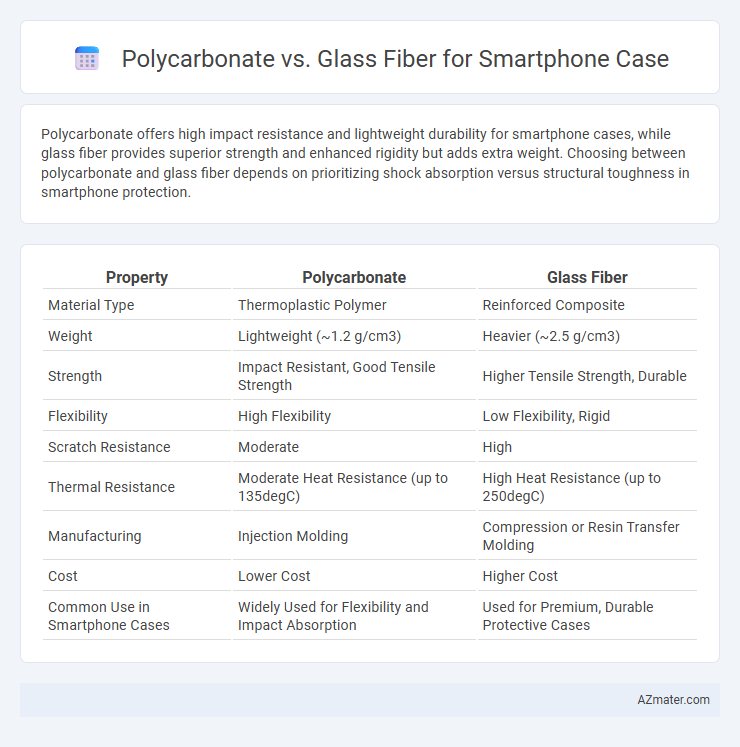Polycarbonate offers high impact resistance and lightweight durability for smartphone cases, while glass fiber provides superior strength and enhanced rigidity but adds extra weight. Choosing between polycarbonate and glass fiber depends on prioritizing shock absorption versus structural toughness in smartphone protection.
Table of Comparison
| Property | Polycarbonate | Glass Fiber |
|---|---|---|
| Material Type | Thermoplastic Polymer | Reinforced Composite |
| Weight | Lightweight (~1.2 g/cm3) | Heavier (~2.5 g/cm3) |
| Strength | Impact Resistant, Good Tensile Strength | Higher Tensile Strength, Durable |
| Flexibility | High Flexibility | Low Flexibility, Rigid |
| Scratch Resistance | Moderate | High |
| Thermal Resistance | Moderate Heat Resistance (up to 135degC) | High Heat Resistance (up to 250degC) |
| Manufacturing | Injection Molding | Compression or Resin Transfer Molding |
| Cost | Lower Cost | Higher Cost |
| Common Use in Smartphone Cases | Widely Used for Flexibility and Impact Absorption | Used for Premium, Durable Protective Cases |
Introduction to Smartphone Case Materials
Smartphone cases primarily utilize polycarbonate and glass fiber due to their distinctive properties enhancing durability and protection. Polycarbonate offers high impact resistance and lightweight features, making it ideal for shock absorption and everyday use. Glass fiber composites provide superior strength and rigidity, ensuring enhanced structural integrity and scratch resistance for premium smartphone protection.
Overview of Polycarbonate Cases
Polycarbonate cases for smartphones offer high impact resistance and lightweight durability, providing excellent protection against drops and scratches. These cases feature optical clarity with good heat resistance, making them ideal for sleek, transparent designs without compromising structural integrity. Polycarbonate's flexibility allows for precise molding and enhanced shock absorption compared to rigid materials like glass fiber, resulting in improved device protection and user experience.
Overview of Glass Fiber Cases
Glass fiber smartphone cases are known for their exceptional strength and lightweight properties, providing superior impact resistance compared to standard materials. The woven fiberglass structure enhances durability while maintaining a slim profile, making these cases highly protective without adding bulk. Their resistance to heat and scratches ensures long-lasting protection, ideal for users seeking robustness alongside style.
Durability Comparison: Polycarbonate vs Glass Fiber
Polycarbonate offers excellent impact resistance and flexibility, making it highly durable against drops and scratches in smartphone cases. Glass fiber, while stronger in tensile strength and heat resistance, can be more brittle under sudden shocks compared to polycarbonate. For long-term durability, polycarbonate cases excel in absorbing impacts without cracking, whereas glass fiber cases provide superior structural rigidity but may suffer from fracture under extreme stress.
Weight and Thickness Differences
Polycarbonate smartphone cases are typically lighter and thinner compared to glass fiber cases, enhancing portability and ease of handling. Glass fiber cases offer greater rigidity and impact resistance but generally add more weight and thickness, which can affect the overall bulk of the device. Choosing between the two materials depends on the balance desired between lightweight convenience and robust protection.
Impact Resistance and Protection
Polycarbonate offers superior impact resistance for smartphone cases due to its high toughness and ability to absorb shocks without cracking, making it ideal for drop protection. Glass fiber, while providing enhanced rigidity and strength, is more prone to brittle failure under sudden impacts, which can compromise overall protection. Consequently, polycarbonate is generally preferred for smartphone cases prioritizing durability and impact absorption.
Design Flexibility and Aesthetics
Polycarbonate offers superior design flexibility for smartphone cases due to its lightweight, moldable nature and ability to be produced in various colors and finishes, enabling intricate shapes and customized textures. Glass fiber, while providing enhanced strength and rigidity, often limits aesthetic options because it requires specific molding processes and typically results in a more rigid, less visually diverse case. Manufacturers favor polycarbonate when prioritizing customizable, sleek designs and vibrant aesthetics without compromising durability.
Cost and Availability
Polycarbonate offers a cost-effective solution for smartphone cases due to its lower production expenses and widespread availability in raw materials. Glass fiber, while providing superior strength and durability, incurs higher manufacturing costs and limited supply chains, making it less accessible for mass-market cases. The affordability and easy procurement of polycarbonate make it the preferred choice for budget-friendly smartphone case manufacturing.
Environmental Impact and Sustainability
Polycarbonate smartphone cases have a higher environmental impact due to their petroleum-based composition and limited recyclability, whereas glass fiber-reinforced cases offer improved durability and potentially longer product lifespans, reducing waste over time. Glass fiber materials can be more challenging to recycle but often result in fewer replacements required, contributing to sustainability through enhanced product longevity. Consumers prioritizing environmental responsibility should evaluate the trade-offs between resource extraction, recyclability, and durability to select the most sustainable smartphone case option.
Conclusion: Choosing the Right Case Material
Polycarbonate offers lightweight durability and impact resistance, making it ideal for everyday phone protection, while glass fiber provides enhanced strength and rigidity suitable for heavy-duty use. Selecting the right case material depends on balancing portability with structural reinforcement needs. For users prioritizing slim design and drop protection, polycarbonate is preferable; those requiring maximum toughness should consider glass fiber cases.

Infographic: Polycarbonate vs Glass fiber for Smartphone case
 azmater.com
azmater.com